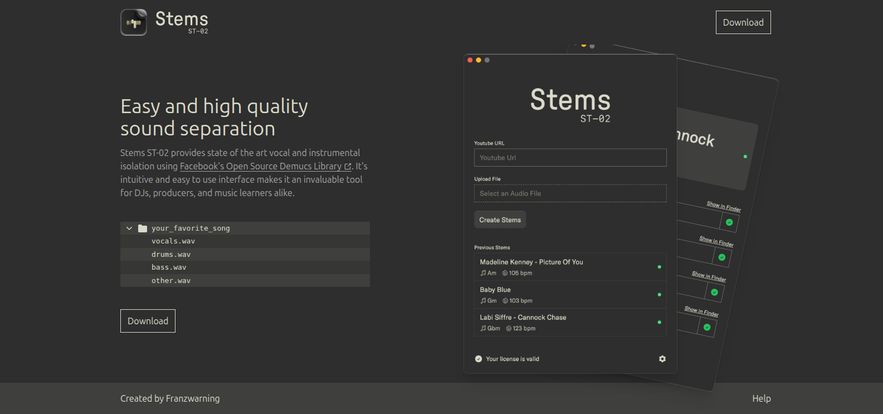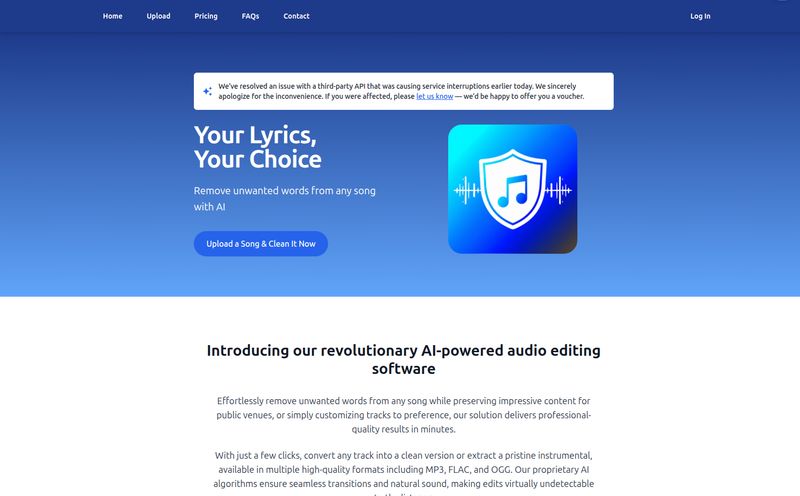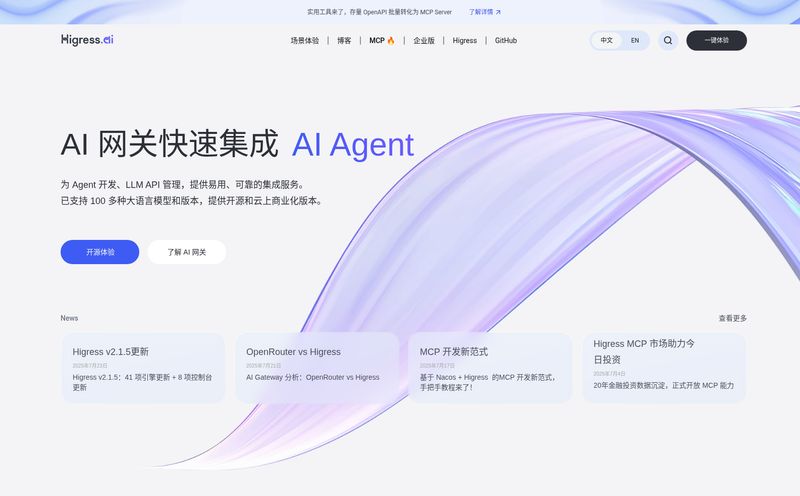I’m going to date myself a bit here. I remember, not so long ago, the dark arts of trying to get a clean acapella. It involved scouring shady forums, trading files on AIM, and the classic DIY method: finding an official instrumental, lining it up perfectly with the original track in your DAW, and inverting the phase. Sometimes, if the stars aligned and the mastering engineer used the exact same chain, you’d get something... usable. Mostly, you got a watery, chorus-filled mess that sounded like the singer was recorded in a fish tank.
It was a headache. A necessary evil for any DJ or producer wanting to get creative with remixes and mashups.
Then, a few years back, tools started popping up that used AI to do the heavy lifting. The game changed. Now, we're in what feels like the third or fourth generation of this tech, and I've just been playing around with a new contender that has seriously caught my attention: Stems ST-02. It’s a slick-looking tool that claims “easy and high quality sound separation.” A bold claim, but one I was eager to put to the test.
So, What Exactly is Stems ST-02?
At its heart, Stems ST-02 is an audio separation tool. Think of it like a prism for sound. You feed it a fully mixed song, and it splits that single beam of light into its constituent colors: vocals, bass, drums, and everything else. It’s created by a developer named Franzwarning, and right off the bat, I appreciate the indie spirit of it. This doesn’t feel like a product from a massive, faceless corporation; it feels like something made by a music lover, for music lovers.
The entire premise is built on simplicity. There are no intimidating panels with a dozen knobs and sliders. You get a clean, dark-mode window with two options: paste a YouTube URL or upload your own audio file. That’s it. You hit “Create Stems,” and it gets to work. Simple. Elegant. My kind of tool.

Visit Stems
The Tech Behind the Magic: From Spleeter to Demucs v4
Okay, let’s get a little nerdy for a second, because this is important. For a while, the gold standard in open-source stem separation was a library from Deezer called “Spleeter.” It was pretty good for its time, but often left behind noticeable digital artifacts—that watery, phasey sound I mentioned earlier. You could tell it was AI-generated.
Stems ST-02 has wisely leapfrogged that and gone straight for the new king: Facebook’s (or Meta’s, I guess) Demucs v4. This isn’t just an incremental update; it’s a whole different beast. Demucs is a deep-learning model that has been trained on a massive dataset of music, and it’s much, much better at understanding the relationships between different sounds in a mix. To put it in an analogy, if Spleeter was using a fairly sharp kitchen knife to cut the parts of a song apart, Demucs v4 is like a set of surgical scalpels. The precision is on another level, resulting in cleaner, more natural-sounding separations with far fewer artifacts.
This is the core reason why a tool like Stems ST-02 can even exist and be so effective. It’s standing on the shoulders of some serious AI research.
A First-Hand Look at the User Experience
Using the app is, honestly, a breeze. The images on the site dont lie. It looks like a downloadable desktop app, which I personally prefer over a web tool for this kind of work—no browser tabs crashing or accidental closures. The main window is minimalist. You drop your file, and it shows up in a “Previous Stems” list. This is a nice touch.
But here’s the kicker, the little feature that made me smile: it also detects the Key and BPM of the track. As a DJ, this is a massive timesaver. No more running the track through a separate piece of software to figure out its key for harmonic mixing. It’s right there, next to your freshly separated stems. It’s a small thing, but it shows the creator understands the actual workflow of their target audience.
Once it’s done processing, you get your separate `.wav` files: `vocals.wav`, `drums.wav`, `bass.wav`, and `other.wav`. The “other” file is the catch-all for synths, guitars, pads—basically all the melodic and harmonic content minus the main vocals and the rhythm section. For remixing, this is often where the gold is buried.
Who Is This Tool Actually For?
The website says it’s for DJs, producers, and music learners, and I’d say that’s spot on.
- For DJs: This is a mashup machine. You can finally grab that acapella from a track that never had an official release and lay it over your favorite instrumental. Or, create your own custom intros and outros by looping the drum track. The creative potential is huge for live sets.
- For Producers: Ever heard a drum break or a bassline in a song and thought, “I wish I could sample that”? Well, now you can. The quality of Demucs v4 means the samples you pull are cleaner than ever before, making them much easier to use in your own productions without sounding muddy or unprofessional. It's a game-changer for remix artists.
- For Music Learners: This is an incredible practice tool. If you’re a bass player trying to learn a tricky line, just isolate the bass track. A drummer can solo the drums to nail a fill. A singer can create their own karaoke tracks from literally any song. It makes active listening and learning by ear so much more accessible.
The All-Important Question: Stems ST-02 Pricing
Alright, let’s talk money. This is often the make-or-break factor for tools like this. And honestly, the pricing model for Stems ST-02 is about as friendly as it gets.
There are two tiers:
| Plan | Features | Price |
|---|---|---|
| Free | 3 Stems per month | $0 |
| Supporter | Unlimited Stems per month, View Stems history, Support | $5 / month |
Let's be real. The free tier is generous enough for anyone who just wants to try it out or has an occasional need for an acapella. But the $5/month Supporter plan is the real story here. Five bucks. That’s less than a fancy cup of coffee. For unlimited, high-quality stem separations? For any working DJ, producer, or even a hobbyist who's serious about their craft, that is an absolute steal. Many competing services charge per track or have much higher monthly subscriptions. This pricing makes Stems ST-02 incredibly accessible.
What I Love and What I'm Still Curious About
The Good Stuff
The quality of the separation is, without a doubt, the main selling point. I threw a few complex tracks at it, and the results were impressive. The vocals were crisp, the basslines were tight, and there was minimal ‘bleeding’ between the tracks. The clean, no-fuss interface is also a huge plus. There is basically zero learning curve. And as I mentioned, the built-in key and BPM detection is just a fantastic quality-of-life feature.
The Question Marks
No tool is perfect, and there are a couple of things I'm still wondering about. The site doesn't specify what input file formats it supports. I assume standard MP3 and WAV are fine, but what about FLAC, AIFF, or M4A? For audiophiles and producers working with lossless files, this is an important detail.
I'm also curious about the processing speed. Is it using cloud-based processing or your local machine's GPU? This will affect how long it takes to separate a track, which can be a factor if you're working on a deadline. These aren't deal-breakers, more like minor details I’d love to see clarified on their site.
Final Thoughts: Is Stems ST-02 Worth the Download?
In a word? Yes. Absolutely.
With a free tier that lets you process three songs a month, there is literally no reason not to download it and give it a try. Stems ST-02 does one thing, and it does it exceptionally well, thanks to the power of the Demucs v4 engine. It strips away the complexity and delivers high-quality results in a package that anyone can use.
For the price of a coffee, the supporter plan unlocks a tool that could fundamentally change your creative workflow as a DJ or producer. The days of hunting for acapellas on sketchy Russian websites are, thankfully, behind us. We’re living in a pretty amazing time for music creation, and Stems ST-02 is a perfect example of that. Go check it out.
Frequently Asked Questions
- What is Stems ST-02?
- Stems ST-02 is a desktop application that uses AI to separate a song into its core components: vocals, bass, drums, and other instruments. It also detects the song's key and BPM.
- How much does Stems ST-02 cost?
- It has two tiers. A free plan that allows for 3 stem separations per month, and a Supporter plan for $5 per month that offers unlimited separations, stem history, and dedicated support.
- What technology does Stems ST-02 use?
- It uses Facebook's (Meta's) Demucs v4 library, which is a state-of-the-art deep learning model known for producing high-quality, clean audio separations with minimal artifacts.
- Who should use Stems ST-02?
- It’s ideal for DJs who want to create mashups and custom edits, music producers looking for clean samples and remix opportunities, and musicians or students who want to isolate specific instruments for practice and learning.
- Is Stems ST-02 a web app or desktop software?
- Based on the interface elements like "Show in Finder" and a prominent "Download" button, it appears to be a downloadable desktop application for your computer, not a browser-based tool.
- Can I use the separated stems for commercial projects?
- This is a legal gray area. While the tool provides the separation, the copyright of the original song still belongs to the artist and label. Using these stems in a commercial release without clearing the sample is likely copyright infringement. For personal use, remixes, and live DJ sets, it's generally fine, but always be aware of copyright law when using other people's music.
Reference and Sources
Stems ST-02 Official Website: The primary source for the application and its features. (As seen in the provided images).
Facebook Research - Demucs: For those interested in the underlying technology, you can read more about it on the official Demucs GitHub page.
Deezer - Spleeter: To understand the previous generation of this tech, information is available on the Spleeter GitHub page.



